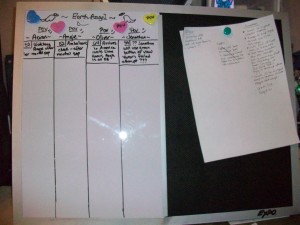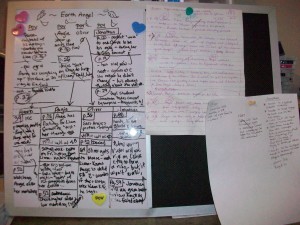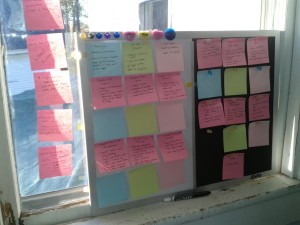So You Want to Write
Storyboarding
 Usually storyboarding refers to creating directions and images for filmmaking, but in my case, I use a type of storyboarding for the writing itself. You can alter my method to meet your needs, but this is how I storyboard –
Usually storyboarding refers to creating directions and images for filmmaking, but in my case, I use a type of storyboarding for the writing itself. You can alter my method to meet your needs, but this is how I storyboard –
You will need a small, magnetic white board. I prefer one with a strip of cork board attached. In fact, my favorite one is half magnetic whiteboard and half cork board. You will also need whiteboard markers, a whiteboard eraser, small magnets, pushpins, and post-it paper. Of course, you can use a tissue for an eraser, and cut paper instead of post-its, and then use pushpins to attach notes to the cork board as you go. I use both – depending on the situation.
The rest is simple –
As I write, I create a board with my POV (point of view) characters – in this picture, I have four  POV characters listed. This is a photo of the actual board I used when I began to write Earth Angel (upcoming release date July 24, 2015.) Anyhow, the picture shows how I write under the character name, exactly where they are, and what I want them to do, which if you know anything about writing, means little, as your characters will take you where they want to go. The interesting thing is that as I revised Earth Angel, I changed the character Aaron to Grace – because that is where the story took me. And what a major rewrite that was! It’s easy to change the name through “find and replace”, but then you have to change every reference to gender – from “he and his” to “she and hers”, not to mention Aaron’s unique story line that had to be completely removed.
POV characters listed. This is a photo of the actual board I used when I began to write Earth Angel (upcoming release date July 24, 2015.) Anyhow, the picture shows how I write under the character name, exactly where they are, and what I want them to do, which if you know anything about writing, means little, as your characters will take you where they want to go. The interesting thing is that as I revised Earth Angel, I changed the character Aaron to Grace – because that is where the story took me. And what a major rewrite that was! It’s easy to change the name through “find and replace”, but then you have to change every reference to gender – from “he and his” to “she and hers”, not to mention Aaron’s unique story line that had to be completely removed.
You’ll note that on the right hand side, I have attached full sheets of paper with important notes that I wanted to be reminded of as I wrote. In this picture, the storyboard is more developed.  You can see how I’ve written page numbers down and brief notes to remind me where I left off with that particular character. This is important, because you want to balance the scenes and make sure you are heading toward the final ending with each subplot.
You can see how I’ve written page numbers down and brief notes to remind me where I left off with that particular character. This is important, because you want to balance the scenes and make sure you are heading toward the final ending with each subplot.
Do you see the yellow heart with POV written on it? At the time this picture was taken, that tells me that I was in Daniel’s POV and on page 64. As I move through the scenes, I cross out where I’ve been and rewrite where my character is now – with the new page number.
In this picture, it shows what I did when I went back and revised the entire story. For Destiny, book three in the No Angel series, I decided to take a chunk of the fourth book (Earth Angel) and incorporate it as part of the story in Destiny – that also made for a major rewrite, but a great addition to Destiny.
Using the post-its, I wrote a short synopsis of each chapter, and where the blank post-its are , was where I knew I had to add more scenes to replace the ones I had removed.
I will be using this exact same process when I split Elias of Elderberry into two books, which is my current WIP (work in progress.) It will help to define what I need to keep in book one, and what I can move to book two, and also where I will need to add more detail and additional scenes.
I find using storyboarding to be a very effective way to write a story. Leave a comment, and let me know what you think!

